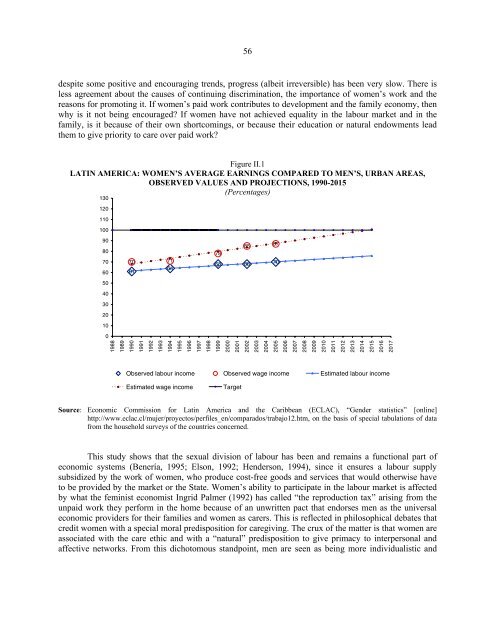Women in Latin America and the Caribbean - Cepal
Women in Latin America and the Caribbean - Cepal
Women in Latin America and the Caribbean - Cepal
You also want an ePaper? Increase the reach of your titles
YUMPU automatically turns print PDFs into web optimized ePapers that Google loves.
56<br />
despite some positive <strong>and</strong> encourag<strong>in</strong>g trends, progress (albeit irreversible) has been very slow. There is<br />
less agreement about <strong>the</strong> causes of cont<strong>in</strong>u<strong>in</strong>g discrim<strong>in</strong>ation, <strong>the</strong> importance of women’s work <strong>and</strong> <strong>the</strong><br />
reasons for promot<strong>in</strong>g it. If women’s paid work contributes to development <strong>and</strong> <strong>the</strong> family economy, <strong>the</strong>n<br />
why is it not be<strong>in</strong>g encouraged If women have not achieved equality <strong>in</strong> <strong>the</strong> labour market <strong>and</strong> <strong>in</strong> <strong>the</strong><br />
family, is it because of <strong>the</strong>ir own shortcom<strong>in</strong>gs, or because <strong>the</strong>ir education or natural endowments lead<br />
<strong>the</strong>m to give priority to care over paid work<br />
Figure II.1<br />
LATIN AMERICA: WOMEN’S AVERAGE EARNINGS COMPARED TO MEN’S, URBAN AREAS,<br />
OBSERVED VALUES AND PROJECTIONS, 1990-2015<br />
(Percentages)<br />
130<br />
120<br />
110<br />
100<br />
90<br />
80<br />
70<br />
60<br />
50<br />
40<br />
30<br />
20<br />
10<br />
0<br />
70 71<br />
61<br />
64<br />
78<br />
85 87<br />
68 68 70<br />
1988<br />
1989<br />
1990<br />
1991<br />
1992<br />
1993<br />
1994<br />
1995<br />
1996<br />
1997<br />
1998<br />
1999<br />
2000<br />
2001<br />
2002<br />
2003<br />
2004<br />
2005<br />
2006<br />
2007<br />
2008<br />
2009<br />
2010<br />
2011<br />
2012<br />
2013<br />
2014<br />
2015<br />
2016<br />
2017<br />
Observed labour <strong>in</strong>come Observed wage <strong>in</strong>come Estimated labour <strong>in</strong>come<br />
Estimated wage <strong>in</strong>come<br />
Target<br />
Source: Economic Commission for Lat<strong>in</strong> <strong>America</strong> <strong>and</strong> <strong>the</strong> <strong>Caribbean</strong> (ECLAC), “Gender statistics” [onl<strong>in</strong>e]<br />
http://www.eclac.cl/mujer/proyectos/perfiles_en/comparados/trabajo12.htm, on <strong>the</strong> basis of special tabulations of data<br />
from <strong>the</strong> household surveys of <strong>the</strong> countries concerned.<br />
This study shows that <strong>the</strong> sexual division of labour has been <strong>and</strong> rema<strong>in</strong>s a functional part of<br />
economic systems (Benería, 1995; Elson, 1992; Henderson, 1994), s<strong>in</strong>ce it ensures a labour supply<br />
subsidized by <strong>the</strong> work of women, who produce cost-free goods <strong>and</strong> services that would o<strong>the</strong>rwise have<br />
to be provided by <strong>the</strong> market or <strong>the</strong> State. <strong>Women</strong>’s ability to participate <strong>in</strong> <strong>the</strong> labour market is affected<br />
by what <strong>the</strong> fem<strong>in</strong>ist economist Ingrid Palmer (1992) has called “<strong>the</strong> reproduction tax” aris<strong>in</strong>g from <strong>the</strong><br />
unpaid work <strong>the</strong>y perform <strong>in</strong> <strong>the</strong> home because of an unwritten pact that endorses men as <strong>the</strong> universal<br />
economic providers for <strong>the</strong>ir families <strong>and</strong> women as carers. This is reflected <strong>in</strong> philosophical debates that<br />
credit women with a special moral predisposition for caregiv<strong>in</strong>g. The crux of <strong>the</strong> matter is that women are<br />
associated with <strong>the</strong> care ethic <strong>and</strong> with a “natural” predisposition to give primacy to <strong>in</strong>terpersonal <strong>and</strong><br />
affective networks. From this dichotomous st<strong>and</strong>po<strong>in</strong>t, men are seen as be<strong>in</strong>g more <strong>in</strong>dividualistic <strong>and</strong>











